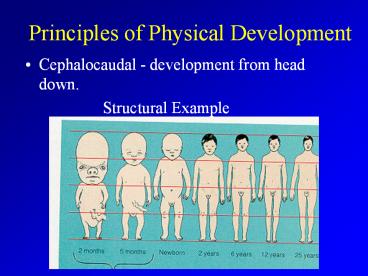Principles of Physical Development - PowerPoint PPT Presentation
Title:
Principles of Physical Development
Description:
Mass-to-specific: gross motor skills (large muscles) develops first followed by ... Occipital lobe vision. Temporal lobe speech/language and hearing ... – PowerPoint PPT presentation
Number of Views:2620
Avg rating:3.0/5.0
Title: Principles of Physical Development
1
Principles of Physical Development
- Cephalocaudal - development from head down.
- Structural Example
2
Cephalocaudal DevelopmentFunctional Example
3
Principles of Physical Development
- Proximodistal development from inside out
- Mass-to-specific gross motor skills (large
muscles) develops first followed by fine motor
(small muscles) skills
4
Growth
- Newborn 20 inches long 7 1/2 pounds
- 1 inch per month
- ½ adult height by age 2
- double weight by 4 months, triple by 12 months
- Head Circumference
- Fontanels
- Ossification
5
Growth
- Adolescence
- Puberty growth spurt - age 9 for girls, 11 for
boys - Sexual maturation
6
Stages of Puberty
- Prepubescent Stage no longer a child but not
yet an adolescent. Secondary sex characteristics
begin to appear, but the reproductive organs are
not yet fully developed. - Pubescent Stage dividing line between
childhood and adolescence. Signs of sexual
maturity appear - the menstrual cycle in girls
and the first nocturnal emissions in boys.
Secondary sex characteristics continue to
develop. Gametes are produced (not in the
quantity/regularity of Fully mature sex organs). - Postpubescent Stage Secondary sex
characteristics become well developed and sex
organs begin to function in a mature manner.
7
Brain Development
- Human brain most functional and best-organized
3 pounds of matter in universe. - Part of Central Nervous System
- Controls voluntary and involuntary activities
- 2 Hemispheres with 4 lobes
8
Development of Brain
9
Brain
10
Lobes
- Occipital lobe vision
- Temporal lobe speech/language and hearing
- Parietal lobe sensory motor processes
- Frontal lobe critical thinking
11
Nervous System Development
12
The Birth and Growth of Neurons
- Most neurons formed halfway through gestation
- Virtually no synaptic connections
- it is experience and interaction with the
environment that forms the synaptic connections - 83 of dendritic growth (connections between
synapses) occurs after birth
13
Childhood
- Synaptogenesis
- Myelination
- Lateralization
- Triples in weight by age 3
14
Use it or lose it Natural Selection of Brain
Wiring
- Exposure to enriched environments with extra
sensory and social stimulation enhances the
connectivity of the synapses - However, children and adolescents can lose up to
20 million per day when not stimulated

